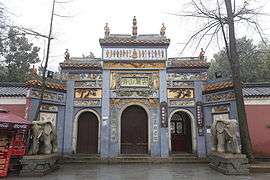Shanmen
| Shanmen | |||||||
|
| |||||||
| Traditional Chinese | 山門 | ||||||
|---|---|---|---|---|---|---|---|
| Simplified Chinese | 山门 | ||||||
| Literal meaning | The Gate of Three Liberations | ||||||
| |||||||

The Shanmen (simplified Chinese: 山门; traditional Chinese: 山門; pinyin: Shānmén), also known as Sangedatsumon or Gate of Three Liberations, is the most important gate of a Chinese Chan Buddhist temple.[1]
The origin of the name
In order to keep away from the secular life, Buddhist temples are often built in unfrequented mountain forests, so the gates are known as the Mount Gates. Gates are usually built in a row with a big one in the middle and two small ones on two sides, which symbolize the gates of three liberations (三解脫門) in the Dharma. Its three gates are called "Kongmen" (空門; emptiness liberation), "wuxiangmen" (無相門; no-aspects liberation) and "wuyuanmen" (無愿門; desireless liberation).[2][3]
Architectural Style
After successive wars and cultural discontinuity, with only one gate, most of the existing ancient Buddhist temples usually follow the hall style or change the middle gate of the three main gates into a hall called "Hall of Three Liberations" or "Hall of Mount Gate" (山門殿).[1]
References
- 1 2 Zi Yan (2012-08-01). Famous Temples in China. Beijing: Time Publishing and Media Co., Ltd. p. 25. ISBN 978-7-5461-3146-7.
- ↑ Wei Ran (2012-06-01). Buddhist Buildings. Beijing: China Architecture & Building Press. ISBN 9787112142880.
- ↑ Han Xin (2006-04-01). Well-Known Temples of China. Shanghai: The Eastern Publishing Co. Ltd. ISBN 7506024772.
Further reading
| Wikimedia Commons has media related to Shanmen. |
- Wang Guixiang (2016-06-17). 《中国汉传佛教建筑史——佛寺的建造、分布与寺院格局、建筑类型及其变迁》 [The History of Chinese Buddhist Temples] (in Chinese). Beijing: Tsinghua University Press. ISBN 9787302427056.
- Zhang Yuhuan (2014-06-01). 《图解中国佛教建筑、寺院系列》 (in Chinese). Beijing: Contemporary China Publishing House. ISBN 9787515401188.
